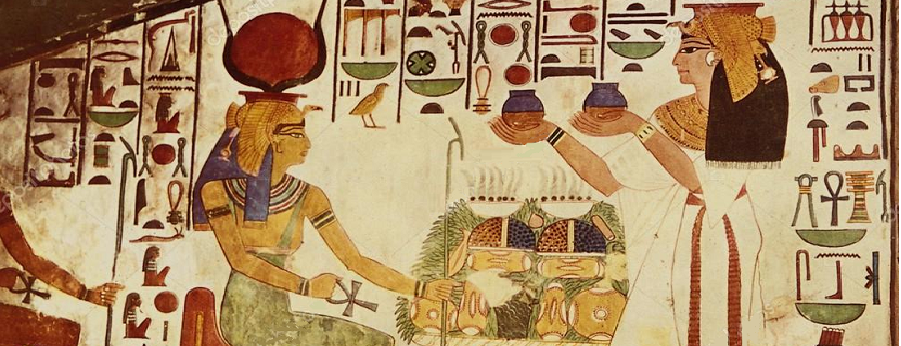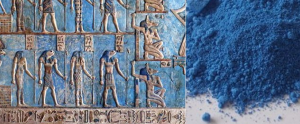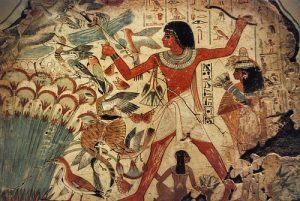Egyptian Painting a Business Profile
August 23, 2023 / Helen Kachur

Tomb of Queen Nefertari Canvas Art
While ancient Egypt battled with a succession of foreigners and local powers, they also built pyramids, temples, and obelisks based on a system of mathematics and stylized beauty. During this time of empire building, Egyptians also explored the science of mineralogy combining ground rock with natural elements to create a variety of paint pigments. By the early Dynastic Period around 3000 BC this new technology experienced developments in processing and marketing of malachite, azurite, gypsum, turquoise, native iron, cinnabar and lime.
Unlike today’s simplicity of squeezing paint from a tube and applying it to a gesso primed canvas, the early Egyptians had to first complete a series of lengthy steps that started with the drying and grinding of natural products. Colors for an Artist’s inspiration were limited and varied from rare stones to charcoal or local spices and flowers, giving insight to the descriptive term of ‘oxblood red.’ Smalt, an important pigment in European oil painting, particularly in the sixteenth and seventeenth centuries found its origins in the blue pigment used by the ancient Egyptians, known as us as ‘Egyptian blue.’ The pigment was made by mixing cobalt oxide with molten glass, the hot glass was submerged in water causing it to shatter into small pieces. The small bits of blue glass were then ground to yield a coarse pigment. However, Egyptian blue contained bits of copper, whereas smalt derives its color from pure cobalt.

Egypt was the first to introduce the washing of pigments to increase hue strength and purity in a process called lake-making. From this method they produced new, deeper richer shades of color. Red, the color of skin, also represented destruction and was made from realgar, an arsenic sulfide mineral known as “ruby Sulphur” or the earlier oxidized iron and red ocher. Green represented goodness or growth and was mixed from malachite, a copper mineral. Bright yellow symbolizing gold, came from orpiment or dried ocher and oxides. Other plant material such as dried cinnamon, peppers, vegetables, leaves, and charcoal were commonly considered as the first pigments for dyes. More information on the materials used to make pigments, as well as a discussion of the symbolism of various colors can be found by searching ‘Aspects of Color in Ancient Egypt’ at Egyptological.
Egyptian artists knew instinctively that the color of hard mineral base paints were fixed and could stand up to the harsh desert sun. However, before paint could be applied to a limestone wall or decorative column, the surface would be planed flat with a clay/mud plaster to reduce the rough texture of limestone. The dried work area would then be treated with a resin or gesso chalk mixture. It was only after days of cleaning and sanding that a prepared surface was set for decoration. Scene elements were first planned and sketched out before drafted onto a wall using a red translucent paint. The creative process to follow was systematic, applying one paint color at a time by hydrating powder pigments with clay or tannin to form a pliable compound that could bind to the gesso surface. Mixing mediums were formed using gums and resin from woody plants or collegian glues obtained from animal hides. These adhesive binders also made the pigment workable as fluid paints with body that could grip to sketched or carved stone and fabric. Through this series of carefully planned application and color selections the Egyptian artists left a well preserved cipher that hints at their ancient way of life, values and beliefs.
Interestingly, among the variety of artifacts found in Tutankhamen’s tomb, meant to accompany the King through his afterlife, was a small wood container or ancient Egyptian paint box. Inside the box were the color pigments orpiment orange, red ochre and malachite. For more information search ‘King Tutankhamun paint box.’


Nebamun hunting birds, Thebes, Egypt, 1350 BC
Article by Ryker P. Stevens, TheArtGuide.com Staff Editor


Comments
YnGupo
Good to see an online article about the origins of color
Aug 14, 2023
MonEart78
The pigments used by the ancient Egyptians were the most diverse palette of ancient history. Even more important may be the binders that moved and sealed the white, green, grey, black, brown, blue, red, orange, and yellow pigments.
Aug 06, 2023
Frank58RevArt
The two main forms of eye makeup were also used in paint; grepond eye paint and black kohl. The green eye paint was made of malachite and the black kohl was made from galena.
Jul 31, 2023